Furthermore, I want a “plastic model” worth dreaming about, one where you can finish construction using the same process as if you were building the real aircraft!
I wonder exactly how much time has passed by since I embraced this longing.
Through the act of construction, it's possible to study the airframe structure, and understand the configuration and workings of various parts as they're being assembled. It's also possible to understand what kind of uses and tactics the strongest reciprocating engine fighter was designed, manufactured, and deployed for, simply from the equipped weapons.
Why the engine, the cockpit, the landing gear and the propeller took the forms that they did, why it was implemented in the season that it was, why it vanished so quietly. The time for these dreams of mine to be realized has finally arrived.
The time has finally come for all of the yearning feeling that has been poured into Tank's 152, all of the burning longing, to be fulfilled.
The first time in my life that I laid eyes on a plastic model airplane, I was still in elementary school. There were two, a twin engine light aircraft called a Piper by a toy maker called Marusan, and a Douglas B-66 jet bomber of which scale I don't know even to this day. A childhood friend of mine, a doctor's son in the same neighborhood, received them from someone as a present, and they were extremely detailed model airplanes, the like of which had never been seen before in those days.
For an elementary student of that time, when speaking of model airplanes, making light planes using wooden dowels, bamboo strips, and paper was the utmost, so just the fact that they were made from a high-tech material such as plastic was a surprising thing in and of itself.
A Piper Cherokee made of colorful yellow plastic, and a Douglass B-66 in coolly shining silver. Although they were small, their existences were so overwhelming that even to this day, I can vividly remember nearly losing myself in the shock that I felt.
After that, whether waking or sleeping, the head of my childhood self was filled with nothing else. Even when I went to school, my textbooks were filled with doodles of airplanes.
I'm sure that my friend took pity on such a severely addicted victim as myself, because one day, “Here!” And he gave me a plastic model assembly manual.
If I recall correctly, it was the assembly manual for the “Hayabusa.” In those days, plastic model assembly manuals were called blueprints, I think.
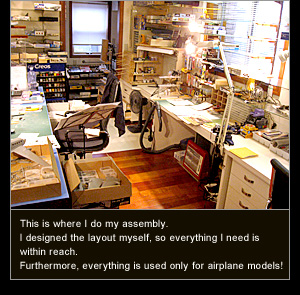
Of course I thanked him reverently, trembling all the while..
I was an elementary student, and all of a sudden, a blueprint depicting many detailed airplane illustrations! From that day on, tracing over those illustrations became my daily routine. The cowling, the body, the bombs on the wings. The propeller, spinning with a thunderous roar.
I don't remember exactly when it started, but ever since, even now when I look up into the blue sky and see the cumulonimbus clouds, it's become as if I can see the shadows of the airplanes passing between them, one by one.
When you entered middle school, it was possible to get a part-time job delivering newspapers or milk. By that time, I was collecting “Maru” and ”Senki Gahou (Illustrated Military Chronicles),” the most outstanding publications of those days, and I had begun to make rounds of the used bookstores with a friend.
Every day I would lose myself in military chronicles of “Oozora No Samurai (Samurai of the Heavens)” and “Katou Hayabusa Sentoutai (Katou's Hayabusa Squadron).” Information from special interest magazines such as “Kokuu Fan (Aviation Fan)” and “Kokuu Jouhou (Aviation Information)” would all come together to fuel a young boy's dreams of the sky.
At the same time, the age of plastic models' rise to popularity had begun. Weekly magazines called boys' magazines, such as “Shounen Magazine (Boy's Magazine)” and “Shounen Sunday (Boy's Sunday),” were also filled with military chronicles. Battleships and fighter planes abounded all over the place. And one day, I discovered some unfamiliar airplane packages displayed in the shop window of a model store that I always visited.
It was the package for what was the ultimate unobtainable prize for model fans in those days, a new release from the American company Revell Inc., the carrier fighter plane called the Skyraider.
Vividly depicted was the heroic image of a dark blue fighter in the very moment of landing on an aircraft carrier.
The image on the box burned itself into my eyes with such transcendent intensity it was as if I could even hear the roar of the aircraft. Even now, I can clearly recall the shock and burning impatience that I felt at the time.
The P-51 Mustang, a Monogram kit by the same American company, also loomed over me.
Waking or sleeping, those two planes continued to fly around the inside of my head. It was also around this time that jet airplanes began to join the reciprocating engine planes in the doodles in my notebooks.
Little by little, I also began to understand that many, many airplanes existed in the world. Japan, America, Germany, Britain, France, the Soviet Union – and the varied, individual aircrafts that represented each country. Each one filled to the brim with personality, and each one also full of unique appeal.
Japanese planes, elegant and beautiful. German planes, truly practical and exuding persistence. Luxurious and gorgeous American planes, and British planes that embodied British nobility. Even the rustic Soviet planes had their own unique flavor. Whichever plane from whichever era of whichever country, I never got tired of looking at the pictures.
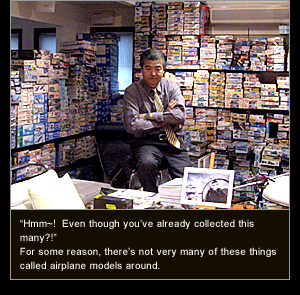
And if possible, someday I wanted to try and create my own plastic models of these airplanes. This dreamlike feeling naturally guided me down the path of managing my own model store.
Besides managing my shop, I don't recall exactly when I started, but I began to build up my model airplane collection little by little, and it currently numbers around 7,000 pieces.

Starting with special interest publications and magazines, things like English books, decals, posters, and even real aircraft parts were, “Ta-da!” enshrined quite spectacularly in the “Gunroom,” the workshop that I built next to my home.
It's already been 50 years since then!
And now, my own company is producing model airplanes. In other words, one by one we are turning my long-cherished dreams into realities.
That is the SWS (Super Wing Series).
To start with, No. 1, a 1/32 scale model of a Japanese aircraft, “Shinden,” has been completed.
Zoukei-mura was originally established as a sculpting company to produce figures, but members who liked mechanics showed understanding of my interests, and after researching the latest documents, made the best Shinden in the world into a reality.
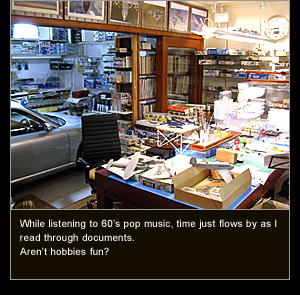
My dream, itself embodied in “Using plastic, that magical material, I want to create a real airplane,” had magnificently taken a 1/32 scale “form” called Shinden.
Furthermore, this Shinden was so substantial that it was as if the actual plane had turned into a plastic model, as the true details of this famous aircraft were successfully expressed, when previously all but the exterior was unfamiliar. Always encouraging and supporting each other, we continued development for two years. To that extent, the fact that we were able to make a model worth seeing and building was a great relief.
The truth about Shinden. It was popular all along within Japan, but starting with Britain and America, we have received many rave reviews from airplane modelers worldwide. In spite of difficult circumstances even obtaining the model, we have actually received words of praise from many hobbyists. It is something we are truly grateful for. And now, again, another part of my dream is finally, finally about to be realized.
That is the SWS No. 2, “The Blade of the Blue Sky,” Tank's Ta 152.
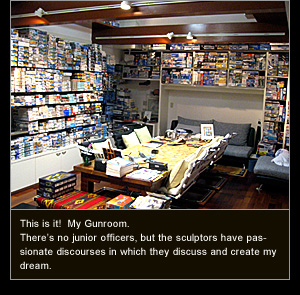
Ever since the planning began to progress, my old familiar fever has returned yet again. Whether waking or sleeping, I am assailed by the heroic figure of Tank's Ta 152 flying through the sky in my head; the gallantry of a Ta 152 in a nosedive, wanting to protect loved ones in its homeland.
And now, the launch date for the Ta 152 is finally drawing near.
Every members of every department is engaged in a monumental effort - rechecking the workmanship of each part, the decals, the instruction manual, and above all, aiming for the ultimate reproduction of the Ta 152.
Isn't it so very promising!! Isn't it so very delightful!! My heart is shrouded with such joy that I find it difficult to breathe from the excited shivers. I believe with no doubt that my dream is the same as the dream of airplane fans worldwide. It will truly be possible to get your hands on the Ta 152!
To all the fans of German airplanes, to all the fans of the Ta 152, I entreat you from the bottom of my heart to pre-order the Ta 152 with all due haste.
Hideyuki Shigeta, President, ZOUKEI-MURA
Using plastic, that magical material, I want to create a real airplane!
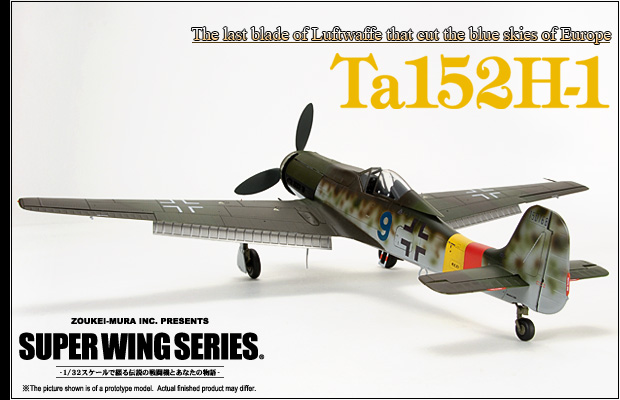
| Product Name | Focke-Wulf Ta152H-1 |
|---|---|
| Price | 9500 JPY (+fee) |
| Model | Injection Plastic Model Kit, molded parts in 4 colors including clear (estimated). |
| Parts | 182 parts (estimated) |
| Size | Length 338mm, Height 133mm, Width 452mm |
| Note | Glue is required for assembly. |
Order via Volks Japan is sold out.
Order via Volks USA is sold out.
The differences between ordering from Volks USA and Volks Japan are:
Archives: The Old Man Blog
- The Old Man Blog No.134Enjoy the best part of SWS kit with the instruction manual. Imperial Japanese Navy fighter aircraft SHINDEN: Episode 2
- The Old Man Blog No.133Enjoy the best part of SWS kit with the instruction manual. Imperial Japanese Navy fighter aircraft SHINDEN: Episode 1
- The Old Man Blog No.132Enjoy the best part of SWS kit with the instruction manual. Focke-Wulf Fw 190 A-4 Siegfried Schnell: Last Episode (Final Outfitting)
- The Old Man Blog No.131Enjoy the best part of SWS kit with the instruction manual. Focke-Wulf Fw 190 A-4 Siegfried Schnell: Episode 4 (Assembling main wings and fuselage, engine mounting and main landing gear)
- The Old Man Blog No.130Enjoy the best part of SWS kit with the instruction manual. Focke-Wulf Fw 190 A-4 Siegfried Schnell: Episode 3 (Fuselage Assembly)
- The Old Man Blog No.129Enjoy the best part of SWS kit with the instruction manual. Focke-Wulf Fw 190 A-4 Siegfried Schnell: Episode 2 (Cockpit)
- The Old Man Blog No.128Enjoy the best part of SWS kit with the instruction manual. Focke-Wulf Fw 190 A-4 Siegfried Schnell: Episode 1 (Engine)
- The Old Man Blog No.127For the first time in three years! Zoukei-Mura participated in IPMS Texas San Marcos in the U.S.!
- The Old Man Blog No.126Enjoy the best part of SWS kit with the instruction manual Part 3: HEINKEL He 219 A-0 Uhu Last Part
- The Old Man Blog No.125Enjoy the best part of SWS kit with the instruction manual Part 3: HEINKEL He 219 A-0 Uhu 2nd
- The Old Man Blog No.124Enjoy the best part of SWS kit with the instruction manual Part 3: HEINKEL He 219 A-0 Uhu
- The Old Man Blog No.123Enjoy the best part of SWS kit with the instruction manual Part 2: Lats Part
- The Old Man Blog No.122Enjoy the best part of SWS kit with the instruction manual Part 2: 2nd
- The Old Man Blog No.121Enjoy the best part of SWS kit with the instruction manual Part 2
- The Old Man Blog No.120The instruction manual for the SWS 1/32 "Bf 109 G-14/U14" is completed!! Part 5
- The Old Man Blog No.119The instruction manual for the SWS 1/32 "Bf 109 G-14/U14" is completed!! Part 4
- The Old Man Blog No.118The instruction manual for the SWS 1/32 "Bf 109 G-14/U14" is completed!! Part 3
- The Old Man Blog No.117The instruction manual for the SWS 1/32 "Bf 109 G-14/U14" is completed!! Part 2
- The Old Man Blog No.116The instruction manual (Japanese version) for the SWS 1/32 "Bf 109 G-14/U14" is completed!! Part 1
- The Old Man Blog No.115Thank you very much for the pre-orders from all over the world!!!
- The Old Man Blog No.114With Engines Roaring!!
- The Old Man Blog No.113Celebrating the 10th Anniversary of SWS!! Thank you for supporting our 35 releases!!
- The Old Man Blog No.112I Hope You’re Doing Well, My SWS Brothers!!!
- The Old Man Blog No.111Your Pre-Ordered Limited-Edition F-4EJ Kai "Phantom Forever 2020" Kit is Coming to You Soon!!
- The Old Man Blog No.110SWS F-4EJ Kai "Phantom Forever 2020" is SOLD OUT via Pre-Order!!! Thank you for all of your pre-orders!!
- The Old Man Blog No.1091/48 F-4EJ Kai Celebrating 10 Years of SWS Thank you all for your early pre-orders!!
- The Old Man Blog No.10810th Anniversary of SWS Kits: The First Commemorative Kit Revealed!!
- The Old Man Blog No.107What's up, SWS fans?!?
- The Old Man Blog No.106We Went to SMC in Telford!!
- The Old Man Blog No.105Let’s Meet at SMW in Telford!!
- The Old Man Blog No.104We’re back from IPMS Nationals in Chattanooga!!!
- The Old Man Blog No.103A Big Hello to All of My SWS Brothers!!
- The Old Man Blog No.102Welcome to the Zoukei-Mura Booth at IPMS Telford! Thank you for purchasing the 1/32 Toryu!!
- The Old Man Blog No.101We went to IPMS Phoenix!! Plus an Exciting Quiz: Guess the Next SWS Airplane!!
- The Old Man Blog No.100Have you got F-4J Marines?
- The Old Man Blog No.099The long-awaited F-4 D, finally available from February 17th (Sat)!!
- The Old Man Blog No.098SWS Brothers from UK & Europe!! Thank you very much!!
- The Old Man Blog No.097The autumn show of hobby world is about to begin!!
- The Old Man Blog No.096We've been here!! Wings Over the Rockies Air & Space Museum!!!
- The Old Man Blog No.095 We went to IPMS Nationals in Omaha!! (Part 2)
- The Old Man Blog No.094 We went to IPMS Nationals in Omaha!! (Part 1)
- The Old Man Blog No.093 Already the beginning of summer?!! But while I was silent, the new release of the F-4S got closer!!
- The Old Man Blog No.092 Happy New Year 2017!
- The Old Man Blog No.091 Greetings for the end of 2016
- The Old Man Blog No.090 Thanks for the instant sell-out!
- The Old Man Blog No.089 SWS F-4J finally ready for its pre-release at the IPMS Telford!!
- The Old Man Blog No.088 The Giant of the Jet-fighters F-4: the Answer from Zoukei-mura - Part 4
- The Old Man Blog No.087 The Giant of the Jet-fighters F-4: the Answer from Zoukei-mura - Part 3
- The Old Man Blog No.086 The Giant of the Jet-fighters F-4: the Answer from Zoukei-mura - Part 2
- The Old Man Blog No.085 The Giant of the Jet-fighters F-4: the Answer from Zoukei-mura - Part 1
- The Old Man Blog No.084 We went to the IPMS Columbia!!
- The Old Man Blog No.083 Hey! Just like I said!! With the SWS kit, you can understand this far the Do 335's secrets!
- The Old Man Blog No.082 SWS Do 335 Thank you for all the reservations we received from all over the world!!
- The Old Man Blog No.081 So, let's build the Do 335!! Last Episode.
- The Old Man Blog No.080 So, let's build the Do 335!! Episode No.5: "this time let me introduce you the work on the main wings!!"
- The Old Man Blog No.079 So, let's build the Do 335!! Episode No.4: "this time I introduce you the work on the main wings!!"
- The Old Man Blog No.078 So, let's build the Do 335!! Episode No.3: "the cockpit is awesome too".
- The Old Man Blog No.077 So, let's build the Do 335!! Episode No.2: "how to build the DB 603 engine".
- The Old Man Blog No.076 So, let's build the Do 335!!
- The Old Man Blog No.075 The soul of a reciprocating engine is finally here!!
- The Old Man Blog No.074 IPMS Telford 2015 Event Report: Episode 3
- The Old Man Blog No.073 IPMS Telford 2015 Event Report: Episode 2
- The Old Man Blog No.072 IPMS Telford 2015 Event Report: Episode 1
- The Old Man Blog No.071 The Old Man's meddling!!
- The Old Man Blog No.070 Here we go!! IPMS Telford 2015 is about to start!!!
- The Old Man Blog No.069 We went to the IPMS Nationals in Ohio!!!
- The Old Man Blog No.068 Come, SWS brothers!
- The Old Man Blog No.067 What is the rear taste of building a kit?
- The Old Man Blog No.066 One of the plastic model kits' tastes (the current taste)
- The Old Man Blog No.065 Spring time! Hobby season has come!!
- The Old Man Blog No.064 Thank you for the pictures of your finished SWS kits!
- The Old Man Blog No.063 Presentation of the finished SWS Horten kit!! 2nd Part!!
- The Old Man Blog No.062 Presentation of the finished SWS Horten kit!!
- The Old Man Blog No.061 The indispensable tools of the Old Man!
- The Old Man Blog No.060 Urgent Notice for all of you who purchased our SWS 1/32 Horten kit!
- The Old Man Blog No.059 IPMS Telford 2014 Event Report: Episode 1
- The Old Man Blog No.058 SWS Horten finally spreads its wing and flies in to the big sky!
- The Old Man Blog No.057 IPMS Virginia 2014 Event Report: Episode 4
- The Old Man Blog No.056 IPMS Virginia 2014 Event Report: Episode 3
- The Old Man Blog No.055 IPMS Virginia 2014 Event Report: Episode 2
- The Old Man Blog No.054 IPMS Virginia 2014 Event Report: Episode 1
- The Old Man Blog No.053 Zoukei-Mura finally headed to IPMS Virginia!
- The Old Man Blog No.052 Development status for SWS HORTEN Kit Part2
- The Old Man Blog No.051 Development status for SWS HORTEN Kit Part1
- The Old Man Blog No.050 Want to see more of HORTEN!!
- The Old Man Blog No.049 The first test shot of SWS Ho 229 is finally getting here!!
- The Old Man Blog No.048 Welcome to JOINT FESTIVAL of our company that will celebrate the 40th Anniversary of Volks Inc!!
- The Old Man Blog No.047 IPMS Telford 2013 Event Report
- The Old Man Blog No.046 IPMS Colorado 2013 Event Report 3
- The Old Man Blog No.045 IPMS Colorado 2013 Event Report 2
- The Old Man Blog No.044 IPMS Colorado 2013 Event Report 1
- The Old Man Blog No.043 The so long-awaited Japanese aircraft episode is starting
- The Old Man Blog No.042 Finally, the long-awaited SWS kit, "He 219 Uhu," has started shipping, in order by reservation!
- The Old Man Blog No.041 The final production prototype for SWS No. 6 Uhu is done
- The Old Man Blog No.040 Cockpit Assembly
- The Old Man Blog No.039 We went this year, as well!! The Nurnberg Toy Fair in Germany!!
- The Old Man Blog No.038 For all of our SWS fans and Uhu fans, I have an apology and an announcement!
- The Old Man Blog No.037 IPMS Telford 2012 Event Report: Part3
- The Old Man Blog No.036 IPMS Telford 2012 Event Report: Part2
- The Old Man Blog No.035 IPMS Telford 2012 Event Report: Part1
- The Old Man Blog No.034 The Opening Day of IPMS Telford is Finally Getting Closer!!
- The Old Man Blog No.033 Event Report from IPMS Florida 2012, Final Part
- The Old Man Blog No.032 Event Report from IPMS Florida 2012, Part2
- The Old Man Blog No.031 Event Report from IPMS Florida 2012, Part1
- The Old Man Blog No.030 Delivering Your Hopes along with My Dreams
- The Old Man Blog No.029 Finally, the SWS Mustang will Take Flight!!!
- The Old Man Blog No.028 The Pre-Order Deadline for the P-51D Mustang is Coming Soon!
- The Old Man Blog No.027 SWS Mustang! Long-Awaited Pre-Order Period Finally Started!!
- The Old Man Blog No.026 Delivering the SWS Mustang to All of You Around the World!!
- The Old Man Blog No.025 I Want to Make the Most Beautiful Mustang through the SWS!!
- The Old Man Blog No.024 Event Report from IPMS in Telford, UK #4
- The Old Man Blog No.023 Event Report from IPMS in Telford, UK #3
- The Old Man Blog No.022 Event Report from IPMS in Telford, UK #2
- The Old Man Blog No.021 Event Report from IPMS in Telford, UK #1
- The Old Man Blog No.020 Is Your SKYRAIDER Already Home?!
- The Old Man Blog No.019 Thank You for Waiting!! Your SKYRAIDER is Finally Coming Home!!
- The Old Man Blog No.018 Took a Trip!! To IPMS "Omaha By The Sea"!!! Part 3
- The Old Man Blog No.017 Took a Trip!! To IPMS "Omaha By The Sea"!!! Part 2
- The Old Man Blog No.016 Took a Trip!! To IPMS "Omaha By The Sea"!!! Part 1
- The Old Man Blog No.015 Package design has reached its final stage!!
- The Old Man Blog No.014 The 'R3350 Engine' and the 'Cockpit' are complete!!
- The Old Man Blog No.013 Japan and the Japanese will recover, once again!!
- The Old Man Blog No.012 SKYRAIDER Test Model 1 Debut, Part 2!!
- The Old Man Blog No.011 The SWS SKYRAIDER will fly over the sky of Nurnberg!
- The Old Man Blog No.010 Is Your Ta 152 Being Brought Up Happily!!??
- The Old Man Blog No.009 The time that Ta 152 fans worldwide have been waiting and waiting for has finally arrived.
- The Old Man Blog No.008 Finally, it's just before the release of the Ta 152!! At last it goes to you!!
- The Old Man Blog No.007 Scale Model Reproduction Must Start with Your Gut Feeling! Is What I've Really Come to Believe.
- The Old Man Blog No.006 Ta 152 Means Wings!!
- The Old Man Blog No.005 Forgive Me, Brothers-in-Arms! At This Point, Just Let Me Announce It~!!!
- The Old Man Blog No.004 Also,The Engine Known As Jumo 213E Is Amazing!!
- The Old Man Blog No.003 This Ta 152 H-1 is Amazing!!
- The Old Man Blog No.002 Using plastic, that magicalmaterial,I wont to create a real airplane!
- The Old Man Blog No.001 Passion for the Product Launch Process

























































































































































































